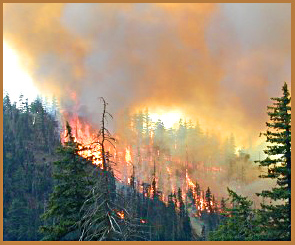
But first, why am I diverting from discussions of modern fabrics, mountain parkas, tents, packs, and sleeping bags?

If we travel back to the Ice Age from which we all emerged, FIRE stands out as an underlying innovation of Mankind that allowed him to survive, and then thrive, in environments outside of the tropics. Sure, early Man killed animals and wore their skins to keep warm enough to survive in cold climates, but the role of Fire cannot be understated. The picture above illustrates one of the most probable ways that primitive Man acquired FIRE.... Let's look at Fire as THE most basic survival tool of Man.
Fire directly warms Man in cold, hostile climates, enabling both short-term stays and long-term habitation.
Fire indirectly warms Man by enabling him to dry off his wearing apparel in climates where natural conditions would otherwise not allow drying to occur (high humidity, sunless, too rainy, etc.)
Fire was the original LIGHTBULB and the original FLASHLIGHT. Without Fire's ability to provide our ancestor's with LIGHT, the exploration and settlement of the dark Northern climates would not have been possible (think of torches being carried around, think of candles being lit by FIRE and being used far away from the group's central fire)
Fire sterilizes things, so crucial in the maintainance of both individual life and the life of family groups.
Fire enables Man to create potable water out of evil waters; note that even survival in the tropics can require this ability of Fire.
Fire cooks things, both animal and vegetable, that would otherwise be inedible by humans; eg. rice or wheat. Often this property will keep people in survival situations alive.
Fire HEATS things, which became the basis for all other technology in Man's rise toward modern camping and climbing gear! How? without Fire's ability to melt things like bronze and iron metals, Man's whole rise out of the Stone Age would never have happened!
Fire enabled Man to drive Cars! How? Without Fire, all that oil oozing out of the ground could never have been refined, nor could it have been burned!
Fire keeps Man safe from all manner of killer animals and other critters, including clouds of mosquitos (and remember that in many areas of the World, mosquitos carry deadly diseases like Malaria).
Fire often can be the key to signalling for help, whether by simply creating a lot of smoke that rises high in the air allowing ground searchers to spot you, or by modern searches utilizing high tech infrared-sensing technology.
Conclusion: as a Survival Tool, even in tropical climates, Fire is the key essential. Never leave home without a Firestarting tool you can rely on.
Underlying Man's use of Fire for all these thousands of years has been the creation of the TOOLS needed to start fires! As has occurred in other aspects of the History of Outdoor Gear, recent modern materials and techniques have greatly improved upon FIRESTARTING TOOLS. And this is very good. Below you will find a few of these improved firestarters. Such tools constitute one of the key items among any hiker's TEN ESSENTIALS, see link to a listing of them.
Copyright 2010-2022 by Bruce B. Johnson M.A.
Most of us are aware of our American pioneers using a technology called "Flint and Steel" to start their fires. Modern technology and materials have allowed some vast improvements to occur. Below is a tool which I own and use. My particular model is the deerhorn handle one. Most recently, the creator now markets a version with a wooden handle- why? He says that in desperate circumstances you might need to shave off the wood to create tinder!
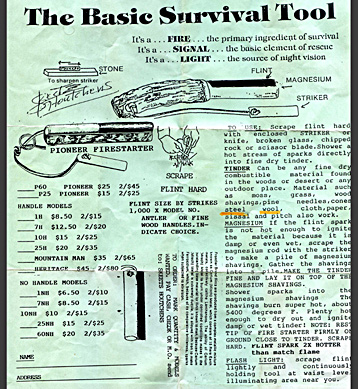
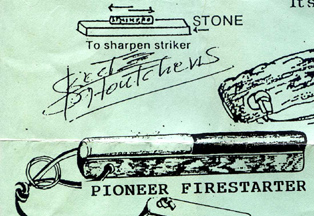
Skeets Houtchens (Charles Houtchens) sold me my deerhorn-handled tool in 2004. As of the end of 2010, Mr. Houtchens is based somewhere on the West Coast. You can see a YouTube video of his survival product in action at this address-- http://www.youtube.com/watch?v=ztH1EYoAMh4&feature=player_embedded#!
The sideways print on the brochure above reads as follows (our Forefathers would have gone to War for this technology!):
"Frontier Brand flints are
produced from a complex metallic mixture known as Cerium (Misch)
Metal, which consists of 15 Rare Earth metals, collectively "callthe
Lanthanons." The ability of Cerium (Misch) Metal to burn
under controlled conditions makes it the outstanding base material
for flints known to Man. Because Cerium (Misch) Metal is extremely
ductile, it is alloyed with iron to make Ferrocclum, which, because
of its comparative brittleness, sparks when subjected to abrasion."
To Use: Scrape flint hard with enclosed STRIKER [the piece
of a hacksaw blade], or a knife, broken glass, chipped rock or
scissor blade. Shower a hot stream of sparks directly into fine
dry tinder." [and the tinder can be supplemented as needed
with Magnesium shavings, which will burn with extraordinary heat,
5,400 degrees F.]" Please note: the elements bracketed with
the [....} are written by me.
STEEL WOOL AND A BATTERY?
Here's a very different kind of
fire-starting tool.... This particular technique is one that I
was skeptical of until I bought the materials myself and tried
it.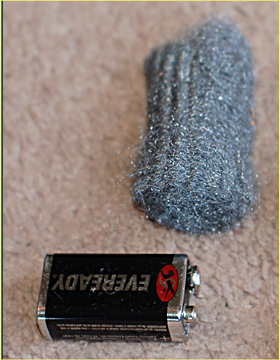 You'll
need three materials-- Steel wool, a 9 volt battery, and tinder
of some sort.. ..use fine grade steel wool. It's simple- the steel
wool will rather spectacularly short out the battery when you
bury the postive and negative terminals into the steel wool. Instantly,
there is steel wool BURNING like it was wood! Of course, now you
must have tinder to pile carefully onto the burning steel wool.
Blowing onto the pile with care will modulate the glow into a
real fire! Also, if needed, this technique could be combined with
the flint and steel, or with magnesium shavings.
You'll
need three materials-- Steel wool, a 9 volt battery, and tinder
of some sort.. ..use fine grade steel wool. It's simple- the steel
wool will rather spectacularly short out the battery when you
bury the postive and negative terminals into the steel wool. Instantly,
there is steel wool BURNING like it was wood! Of course, now you
must have tinder to pile carefully onto the burning steel wool.
Blowing onto the pile with care will modulate the glow into a
real fire! Also, if needed, this technique could be combined with
the flint and steel, or with magnesium shavings.
TINDER AT HOME:
The making of tinder at home is an easy process. I like the process of making "Char Cloth" using old cotton clothing like T-shirts. The end product is an excellent free tinder that is extremely lightweight and easy to carry in your emergency kit. The process is outlined in a fine YouTube film at this address: http://www.youtube.com/watch?v=r7uLVGrAt1M&NR=1
And now, take a Look: World's Best Survival Matches-- Can't put 'em out, even underwater! These things are designed by a long-standing firm named Bryant and Mays in England, I think mostly for mariners under the worst of North Atlantic storms. They are essentially miniature flares, almost impossible to put out with water! On a dark night, you could probably also light the whole box on fire and be spotted by that airplane that is searching for you. Beware around children, these things light up so vigorously that a child will be likely to freak out and drop it somewhere, and no matter where that place is, this match will not go out until it has burned itself out!
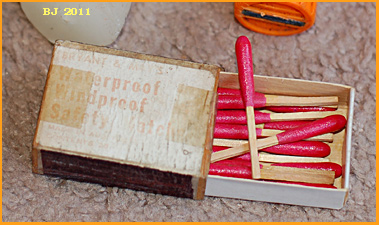
Please Note: All Material here, and in all my "History of Gear" webpages, is copyrighted, and no usage of my material is permitted unless explicit permission is granted by me, Bruce B. Johnson, owner of OregonPhotos.com. Questions? Please contact me soon (oldgear@Oregonphotos.com) .... Disclaimer: The material on this page represents only the reports of the correspondents and my own interpretation of those reports. In many cases "History of Gear" material is difficult to independently verify and that is a "given" in this type of research. It is important to keep in mind that the events, gear, and personages reported in the "History of Gear" lie far in the past, in some cases as much as 60 years in the past. It is common that even people who were within the same company so many years ago will remember/interpret happenings in quite different ways.
"He was never content to follow the beaten path or to accept the usual interpretations..." (*). Although Dr. Wallace Carothers was not known as a hiker or backpacker, his 1935 invention of Nylon changed everything (U.S. patents issued Sept. 1938).... By the end of World War II, his nylon 6,6 had been developed and refined into strong, lightweight spun fabrics which had found their way into the hands of such pioneering gear innovators as Alice Holubar and Gerry Cunningham. Soon Alice was sewing up wonder sleeping bags of down and nylon; she and others found uses for nylon in packs and tents that changed gear from horse-packable to backpackable; and clothing itself had entered a new era of warmth and lightness. It is my belief that nylon was a key underlying material in the transition from car camping to backpacking. Gear became ever lighter, stronger, more compressible, and more resistant to mold and mildew. By the early 1960s, Gerry Cunningham's renowned "20 pound camp" became a reality, and by the early 1970s the backpacking gear industry was booming.
*James B. Conant, who became President of Harvard College, said of Wallace, ""In his research, Dr. Carothers showed even at this time the high degree of originality which marked his later work. He was never content to follow the beaten path or to accept the usual interpretations of organic reactions. His first thinking about polymerization and the structure of substances of high molecular weight began while he was at Harvard." Dr. Carothers was born in 1896, and died a rather tragic death in 1937.
The naming of
Nylon. Dupont needed a common name,
and hit upon "nylon." In 1940, John W. Eckelberry of
DuPont stated that the letters "nyl" were arbitrary
and the "on" was copied from the suffixes of other fibers
such as cotton and rayon (source: Wikipedia).
In describing nylon, Popular Science magazine said "Silk’s
rival is spun out of air, water and coal" (Jan 1946) (air
= oxygen and nitrogen). The same article noted that even in 1946,
90% of nylon was being used in the manufacture of women's hosiery.
In the New Millenium, products made of dozens of permutations
of nylon are nearly omnipresent in the world of outdoor gear.
Dupont has become the multi-national giant INVISTA, one of whose
many fabrics is that vintage pack fabric Cordura, now in many
variants. Visit the INVISTA
site to
be surprised.
BOOK ALERTS: My first book in a grpwomg series about The History of Gear is titled "Frostline Kits of Colorado." Please visit my FROSTLINE PAGE for a link to order it, or to view a free 15 page PDF preview. The second book was released May 2008 and is titled, "GERRY, To Live in the Mountains" (click here). The third book was released in November 2009 and covers the story of Holubar Mountaineering... My fourth book is about the early history of MSR of Seattle, under its often controversial leader Larry Penberthy...Most recently, I have completed a book about that most controversial of the early pioneers, Jack Stephenson of Stephenson's Warmlite Equipment.... Other books are in development, such as one that will pull together several of the smaller gear companies into one book, among them Synergy Works, Moonstone, A16, and Early Winters of Seattle.